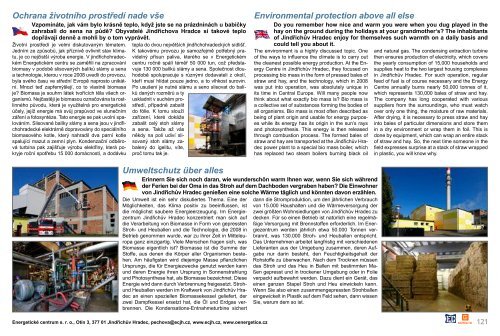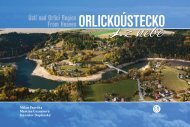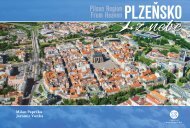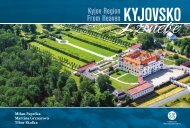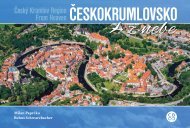You also want an ePaper? Increase the reach of your titles
YUMPU automatically turns print PDFs into web optimized ePapers that Google loves.
Ochrana životního prostředí nade vše<br />
Vzpomínáte, jak vám bylo krásně teplo, když jste se na prázdninách u babičky<br />
zahrabali do sena na půdě? Obyvatelé Jindřichova Hradce si takové teplo<br />
dopřávají denně a mohli by o tom vyprávět.<br />
Životní prostředí je velmi diskutovaným tématem.<br />
Jedním ze způsobů, jak příznivě ovlivnit stav klimatu,<br />
je co nejčistší výroba energie. V jindřichohradeckém<br />
Energetickém centru se zaměřili na zpracování<br />
biomasy v podobě slisovaných balíků slámy a sena<br />
a technologie, kterou v roce 2008 uvedli do provozu,<br />
byla svého času ve střední Evropě naprosto unikátní.<br />
Mnozí teď zapřemýšlejí, co to vlastně biomasa<br />
je? Biomasa je souhrn látek tvořících těla všech organismů.<br />
Nejčastěji je biomasou označována ta rostlinného<br />
původu, která je využitelná pro energetické<br />
účely, jejíž energie má svůj prapůvod ve slunečním<br />
záření a fotosyntéze. Tato energie se pak uvolní spalováním.<br />
Slisované balíky slámy a sena jsou v jindřichohradecké<br />
elektrárně dopravovány do speciálního<br />
biomasového kotle, který nahradil dva parní kotle<br />
spalující mazut a zemní plyn. Kondenzační odběrová<br />
turbína pak zajišťuje výrobu elektřiny, která pokryje<br />
roční spotřebu 15 000 domácností, a dodávku<br />
tepla do dvou největších jindřichohradeckých sídlišť.<br />
K takovému provozu je samozřejmě potřebný pravidelný<br />
přísun paliva, kterého se v Energetickém<br />
centru ročně spálí téměř 50 000 tun, což představuje<br />
130 000 balíků slámy a sena. Společnost dlouhodobě<br />
spolupracuje s různými dodavateli z okolí,<br />
kteří musí hlídat pouze jedno, a to vlhkost surovin.<br />
Po usušení je nutné slámu a seno slisovat do balíků<br />
daných rozměrů a ty<br />
uskladnit v suchém prostředí,<br />
případně zabalit<br />
do fólie. K tomu slouží<br />
zařízení, které dokáže<br />
zabalit celý stoh slámy<br />
a sena. Takže až vás<br />
někdy na poli udiví slisovaný<br />
stoh slámy zabalený<br />
do igelitu, víte,<br />
proč tomu tak je.<br />
Environmental protection above all else<br />
Do you remember how nice and warm you were when you dug played in the<br />
hay on the ground during the holidays at your grandmother‘s? The inhabitants<br />
of Jindřichův Hradec enjoy for themselves such warmth on a daily basis and<br />
could tell you about it.<br />
The environment is a highly discussed topic. One<br />
of the ways to infl uence the climate is to carry out<br />
the cleanest possible energy production. At the Energy<br />
Centre in Jindřichův Hradec, they focused on<br />
processing bio mass in the form of pressed bales of<br />
straw and hay, and the technology, which in 2008<br />
was put into operation, was absolutely unique in<br />
its time in Central Europe. Will many people now<br />
think about what exactly bio mass is? Bio mass is<br />
a collective set of substances forming the bodies of<br />
all organisms. Bio mass is most often described as<br />
being of plant origin and usable for energy purposes<br />
while its energy has its origin in the sun’s rays<br />
and photosynthesis. This energy is then released<br />
through combustion process. The formed bales of<br />
straw and hay are transported at the Jindřichův Hradec<br />
power plant to a special bio mass boiler, which<br />
has replaced two steam boilers burning black oil<br />
and natural gas. The condensing extraction turbine<br />
then ensures production of electricity, which covers<br />
the yearly consumption of 15,000 households and<br />
supplies heat to the two largest housing complexes<br />
in Jindřichův Hradec. For such operation, regular<br />
feed of fuel is of course necessary and the Energy<br />
Centre annually burns nearly 50,000 tonnes of it,<br />
which represents 130,000 bales of straw and hay.<br />
The company has long cooperated with various<br />
suppliers from the surroundings, who must watch<br />
over only one thing, the moisture of raw materials.<br />
After drying, it is necessary to press straw and hay<br />
into bales of particular dimensions and store them<br />
in a dry environment or wrap them in foil. This is<br />
done by equipment, which can wrap an entire stack<br />
of straw and hay. So, the next time someone in the<br />
field expresses surprise at a stack of straw wrapped<br />
in plastic, you will know why.<br />
Umweltschutz über alles<br />
Erinnern Sie sich noch daran, wie wunderschön warm Ihnen war, wenn Sie sich während<br />
der Ferien bei der Oma in das Stroh auf dem Dachboden vergraben haben? Die Einwohner<br />
von Jindřichův Hradec genießen eine solche Wärme täglich und könnten davon erzählen.<br />
Die Umwelt ist ein sehr diskutiertes Thema. Eine der<br />
Möglichkeiten, das Klima positiv zu beeinfl ussen, ist<br />
die möglichst saubere Energieerzeugung. Im Energiezentrum<br />
Jindřichův Hradec konzentriert man sich auf<br />
die Verarbeitung von Biomasse in Form von gepressten<br />
Stroh- und Heuballen und die Technologie, die 2008 in<br />
Betrieb genommen wurde, war zu ihrer Zeit in Mitteleuropa<br />
ganz einzigartig. Viele Menschen fragen sich, was<br />
Biomasse eigentlich ist? Biomasse ist die Summe der<br />
Stoffe, aus denen die Körper aller Organismen bestehen.<br />
Am häufi gsten wird diejenige Masse pfl anzlichen<br />
Ursprungs, die für Energiezwecke genutzt werden kann<br />
und deren Energie ihren Ursprung in Sonnenstrahlung<br />
und Photosynthese hat, als Biomasse bezeichnet. Diese<br />
Energie wird dann durch Verbrennung freigesetzt. Strohund<br />
Heuballen werden im Kraftwerk von Jindřichův Hradec<br />
an einen speziellen Biomassekessel geliefert, der<br />
zwei Dampfkessel ersetzt hat, die Öl und Erdgas verbrennen.<br />
Die Kondensations-Entnahmeturbine sichert<br />
dann die Stromproduktion, um den jährlichen Verbrauch<br />
von 15.000 Haushalten und die Wärmeversorgung der<br />
zwei größten Wohnsiedlungen von Jindřichův Hradec zu<br />
decken. Für so einen Betrieb ist natürlich eine regelmäßige<br />
Versorgung mit Brennstoffen erforderlich. Im Energiezentrum<br />
werden jährlich etwa 50.000 Tonnen verbrannt,<br />
was 130.000 Stroh- und Heuballen entspricht.<br />
Das Unternehmen arbeitet langfristig mit verschiedenen<br />
Lieferanten aus der Umgebung zusammen, deren Aufgabe<br />
nur darin besteht, den Feuchtigkeitsgehalt der<br />
Rohstoffe zu überwachen. Nach dem Trocknen müssen<br />
das Stroh und das Heu in Ballen mit bestimmten Maßen<br />
gepresst und in trockener Umgebung oder in Folie<br />
verpackt aufbewahrt werden. Dazu dient ein Gerät, das<br />
einen ganzen Stapel Stroh und Heu einwickeln kann.<br />
Wenn Sie also einen zusammengepressten Strohballen<br />
eingewickelt in Plastik auf dem Feld sehen, dann wissen<br />
Sie, warum dem so ist.<br />
Energetické centrum s. r. o., Otín 3, 377 01 Jindřichův Hradec, pechova@ecjh.cz, www.ecjh.cz, www.oenergetice.cz<br />
121


